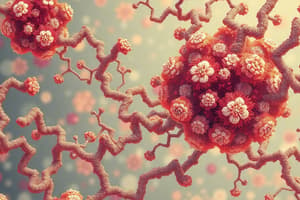Podcast
Questions and Answers
What are the building units of proteins?
What are the building units of proteins?
- Lipids
- Carbohydrates
- Amino acids (correct)
- Nucleotides
How many amino acids are occurring in the human body?
How many amino acids are occurring in the human body?
- 20 (correct)
- 22
- 18
- 24
Which amino acids differ from each other by the R-groups?
Which amino acids differ from each other by the R-groups?
- Only the essential amino acids
- Only the non-essential amino acids
- All amino acids
- All amino acids except glycine and proline (correct)
Based on what are amino acids chemically classified?
Based on what are amino acids chemically classified?
Which amino acid is not of the L- α amino acid except category?
Which amino acid is not of the L- α amino acid except category?
What are the organic acids that contain hydrogen atom, a carboxyl group, an amino group, and a side-chain (R group), all attached to the α-carbon?
What are the organic acids that contain hydrogen atom, a carboxyl group, an amino group, and a side-chain (R group), all attached to the α-carbon?
Which type of amino acids have side chains that contain hydrocarbon or alkyl side chains?
Which type of amino acids have side chains that contain hydrocarbon or alkyl side chains?
Which amino acid has a side chain with a sulphur group but ends with CH3?
Which amino acid has a side chain with a sulphur group but ends with CH3?
Which type of amino acids prefer to function in an aqueous environment?
Which type of amino acids prefer to function in an aqueous environment?
Which amino acids give rise to acetate or acetoacetate on catabolism?
Which amino acids give rise to acetate or acetoacetate on catabolism?
Which type of nitrogen balance occurs when nitrogen loss exceeds incorporation?
Which type of nitrogen balance occurs when nitrogen loss exceeds incorporation?
Which type of amino acids must be supplied in the diet because they cannot be synthesized in the human body?
Which type of amino acids must be supplied in the diet because they cannot be synthesized in the human body?
Which type of amino acids have side chains that are in the interior of the protein molecule?
Which type of amino acids have side chains that are in the interior of the protein molecule?
Flashcards are hidden until you start studying
Study Notes
Proteins and Amino Acids
- Amino acids are the building units of proteins.
- There are 20 amino acids that occur in the human body.
- Amino acids differ from each other by their R-groups.
- Amino acids are chemically classified based on the properties of their R-groups.
- Glycine is the only amino acid that is not of the L-α amino acid except category.
- Amino acids are organic acids that contain a hydrogen atom, a carboxyl group, an amino group, and a side-chain (R group), all attached to the α-carbon.
- Non-polar amino acids have side chains that contain hydrocarbon or alkyl side chains.
- Methionine has a side chain with a sulphur group that ends with CH3.
- Hydrophilic amino acids prefer to function in an aqueous environment.
- Ketogenic amino acids give rise to acetate or acetoacetate on catabolism.
- A negative nitrogen balance occurs when nitrogen loss exceeds incorporation.
- Essential amino acids must be supplied in the diet because they cannot be synthesized in the human body.
- Hydrophobic amino acids have side chains that are in the interior of the protein molecule.
Studying That Suits You
Use AI to generate personalized quizzes and flashcards to suit your learning preferences.




